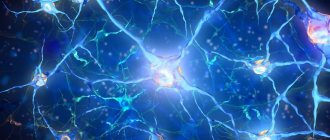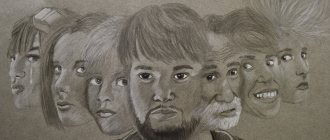Diseases such as schizophrenia and bipolar disorder affect a large number of people around the world. Both men and women are susceptible to these diseases, but in the stronger half, this disorder may begin to manifest itself earlier. The first psychotic episodes appear from about 15-26 years old, while in women - only from 25-26 years old.
The appearance of symptoms of these diseases is rare before 10 and after 50 years.
Both diseases are considered severe mental disorders that require medication. Self-medication or traditional medicine in these cases are powerless and can aggravate the situation. Bipolar schizophrenia is difficult to diagnose due to the presence of symptoms associated with depression or nervousness.
Scientists' conclusions about the nature of schizophrenia and bipolar disorder
American scientists, having compared gene expression profiles in patients with different types of mental disorders, came to the conclusion that the development of diseases such as autism, schizophrenia and bipolar disorder follows almost the same mechanism. However, scientists cannot yet say what changes at the molecular level in the brains of patients when these mental disorders occur. The fact that gene expression profiles are similar only indicates similar developmental mechanisms, and not the relatedness of these diseases.
Bipolar disorder affects almost 7% of the world's population.
Previously, this disease was called manic-depressive psychosis. This mental illness is characterized by extreme mood swings. Such mood swings occur several times a year, but can occur once every few years.
There are two types of bipolar affective disorder (BD), as well as a milder form called cyclothymia. In the clinic of bipolar disorder, various affective disorders predominate, and in the clinic of schizophrenia, thought disorders predominate. In addition, mood swings in bipolar disorder are associated with the balance of norepinephrine and serotonin, and schizophrenia is associated with imbalances in dopamine.
Bipolar disorder is often hereditary. This disease cannot yet be cured, but the condition can be corrected with the help of psychotherapy and medications. You need to control your bipolar disorder throughout your life.
Can the disorder progress to schizophrenia?
The clinical manifestations of these conditions are similar. The causes of these disorders are deep depression, failures in life, work, relationships, as well as genetic predisposition.
The transition of the disorder to schizophrenia is impossible.
Thus, a person’s mental health depends on many factors in his life, including genetic predisposition. To avoid schizophrenia and other mental disorders or reduce the likelihood of their occurrence, it is necessary to avoid stressful situations, try to maintain peace of mind, and be balanced. If you suspect a change in your mental state, you should consult a specialist.
Symptoms of the manic stage of bipolar disorder
The stage of depression can immediately or after a certain period of normal mood be replaced by the stage of mania of elevated mood . Its symptoms:
- increased motor and sexual activity;
- emotional upsurge;
- good mood;
- lack of appetite and almost complete refusal to eat;
- lack of sleep, as the need for it disappears;
- a feeling of one’s genius, omnipotence;
- accelerated, almost disordered speech;
- desire to implement many projects and ideas that change quickly;
- lack of order in actions and thoughts;
- absent-mindedness;
- lack of concentration.
These stages, alternating, can last from several weeks to several years. But most often they replace each other after six months. A person cannot manage this shift. The order of the stages and their duration can never be predicted. As a rule, light (manic) stages are almost three times shorter than depressive (dark) stages.
The hypomanic stage (milder) can hardly be called a disease. After all, a person is cheerful, active, feels a surge of strength, behaves at ease in society, works intensively and is bursting with ideas, and does not feel tired. But during this period, an individual can thoughtlessly waste money, loses the sense of danger and the ability to rationally assess the situation, and easily takes risks.
When hypomania turns into mania, the patient's thoughts are confused, ideas resemble delirium; aggressiveness and persecution mania appear.
Stages of the depressive phase
1. Initial stage. The patient is attacked by apathy, as a result of which his mood deteriorates and he is completely unable to work. Most patients in this condition have trouble falling asleep.
2. Increasing depression. The patient's mood drops sharply, everything falls out of his hands and there is retardation in his movements. In addition, appetite disappears, and weak sleep is often interrupted by night awakenings.
3. Severe depression. Symptoms of the disease reach their highest level. The patient becomes withdrawn and tense, speaks quietly, often in a whisper. Some patients at such moments can sit motionless for a long time, staring at one point. They may have thoughts of their own uselessness and suicide.
4. Reactive stage. The person’s condition returns to normal, and soon nothing reminds of the recent attack.
Sometimes this disease is accompanied by various hallucinations. Such people may either refuse to eat altogether, or overeat to the point of vomiting, suffer from insomnia, or sleep for days on end.
To better imagine people suffering from bipolar disorder, here are two reviews from relatives of such patients.
Angela, 45 years old: “My 40-year-old sister has bipolar disorder. No husband, no children. She was admitted to a psychiatric hospital several times, but without noticeable improvement. Life with such a person is a real nightmare, constant screaming and swearing, any remark is immediately responded to with insults and swearing. At the same time, she is fixated on sins and repentance. He washes the stairwell around the clock, cooks porridge in huge pots for the poor, while not washing his own clothes for months, throws clean clothes out of the house and quarrels with neighbors over any reason. Attempts to call a brigade and calm the sister down yield no results. When doctors appear, he immediately changes his mind and behaves appropriately. I don’t have the strength to fight her behavior.”
Oksana, 39 years old: “My husband has this diagnosis, and my husband understands this perfectly. But that doesn’t stop him from harassing me day after day. Makes me to blame for all his troubles, constantly lives with the feeling that everyone has betrayed him, and the main traitor is me. He blames me for being fired from his job (he is a good specialist, but due to the nature of his illness, no one keeps him at work). I haven’t heard logic in his reasoning for a long time. During periods of “enlightenment” he repents, asks for forgiveness, promises to settle all problems, but literally 2 hours later there are again screams, reproaches and insults. And the calmer you try to talk to him, the angrier he gets. Due to lack of work, he started taking drugs. He became even more aggressive and began to open his arms. Relatives try not to interfere; those around him consider him abnormal. Tell me how to help a person?”
One can only imagine the despair of relatives who have to live with people suffering from such a disorder. But how can we help such people, and is it possible to return peace to the families where such patients live?
Diagnosis and treatment of bipolar disorder
Diagnosis of bipolar disorder can only be made by a psychiatrist based on medical history, symptoms of the disease, brain examination data and blood tests.
The doctor makes a diagnosis of bipolar disorder I if the patient exhibits symptoms of mania and depression, and if hypomania and depression, then the diagnosis is bipolar disorder II.
Mood stabilizing medications are used to treat bipolar disorder. This could be: lithium, anticonvulsants, antidepressants. Sometimes it is also necessary to treat insomnia and disorders of the thyroid gland. Along with medications, methods of psychotherapy, family and group therapy, and phototherapy are necessarily used.
When psychological and drug treatments are unsuccessful and the patient's condition worsens, the doctor may recommend the use of electroconvulsive (shock) therapy.
The causes of bipolar disorder have not yet been fully identified. But genetics, the influence of the endocrine system, and the structure of the brain play a big role here.
Schizophreniform disorder
Its main difference from schizophrenia is the duration of symptoms, as well as the absence of a clear cause.
Epidemiology
Schizophreniform disorder is observed in all cultures, and in 50% of cases in representatives of the schizoid personality type. According to recent studies, less than 1% of the population suffers from it . If parents suffer from schizophrenia, the risk that children will have this disorder with possible progression to schizophrenia is 20-40%.
Although this condition can affect both sexes, it is more common in young men. 30% experience no further symptoms after the first episode, but the remaining 70% experience relapses with a tendency toward chronic schizophrenia.
Find out more on this topic: Mental disorders: 14 of the strangest and most unsolved diseases
Schizophreniform disorder and its symptoms
The main symptoms of schizophreniform disorder are the same as those of schizophrenia, with two main differences :
- Firstly, the total duration of the disease. As we mentioned above, for a diagnosis to be made, at least one, but not more than six, months must pass from the onset of symptoms. In addition, the disease is not necessarily associated with social or occupational disability.
Symptoms of schizophreniform disorder are divided into two groups: productive and negative .
The patient may hallucinate, experience paranoia (productive symptoms), or show complete apathy towards life (negative symptoms).
Productive symptoms
They are understood as those symptoms that add something to the patient’s personality. Here are the main ones:
- Hallucinations. These are sensations that the patient experiences through any of the five senses, without receiving any external stimulation. The most common example is seeing or hearing things or people that don't exist.
- Rave. Distorted ideas that the patient supports with extreme conviction. They usually cause discomfort or anxiety. Most often this is a delusion of persecution, although there may also be a desire for control.
- Disorganization of speech and thinking. We are talking about the loss of logical connections in thinking. The patient's speech becomes incoherent to others.
- Strange behavior. This may be strong excitement, manifested in screaming for no reason, or illogical behavior, for example, the desire to wear winter clothes in the summer.
Negative symptoms
These include symptoms associated with the loss of normal mental reactions. The most important are the following:
- Affective pathology. The patient experiences dulling of emotions. For example, he avoids looking at someone or speaks monotonously.
- Apathy and abulia (lack of will) . Apathy is a lack of interest in anything, and abulia is a decrease in energy potential. The patient, for example, may be aware of the need for personal hygiene, but is not able to carry out the necessary actions.
- Anhedonia and social isolation. Anhedonia is the inability to experience pleasure in activities that the patient previously enjoyed doing.
- Alogia, or limited use of speech in mental disorders. Lack of additional, spontaneous content in speech. The patient suffers from poverty of thinking.
You may be interested in: The Passive-Aggressive Personality is a Great Manipulator: 3 Things You Need to Know!
Five main types of schizophrenia
Early diagnosis and treatment can prevent many unnecessary complications and improve the chances of recovery, so if you are worried that you or someone you know is experiencing episodes of schizophrenia, do not hesitate to seek professional help. Recovering from the disease of schizophrenia will not happen overnight.
Finding the right treatment takes a long time and, of course, there are failures along the way. Of course, it is unlikely that schizophrenia can be cured completely, but in fact, over time, most people with this disease get better.
Therefore, no matter what challenges are currently faced, there is always hope. To understand the prospects for treatment, it is necessary to understand what the types of schizophrenia are.
Modern psychiatry suggests that paranoid schizophrenia is the most common type of illness. It is a subtype of schizophrenia in which the patient has illusions (false assumptions) that a person or some people are plotting some kind of crime against him or their family members.
Most people with paranoid schizophrenia, as with most schizophrenic subtypes, may also have auditory hallucinations—they hear things that are not real. They may also suffer from delusions of grandeur, which is the false belief that they are much more powerful than they really are.










